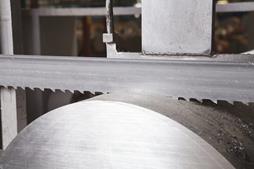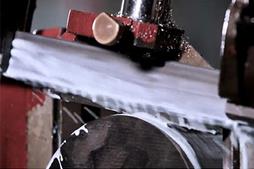How do I choose the correct bandsaw blade for my saw? Our handy guide below might help!
15-03-2022
1. Analyse Application
MACHINE
What bandsaw are you using? Brand name, Brand type and
machine type. The right blade dimensions depend on the
saw you are using.
OTHER NEEDS
Besides the machine specifications it is very important to check the condition in which the machine is. Check at least the condition of the wheels, guides, swarf brush and coolant.
2. Determine the Product
Carbide Blades
Bahco produces a comprehensive range of set and unset carbide bandsaw blades to ensure that we can meet the demands of our production cutting customers.
High performance backing steel and optimized carbide grades give premium bandsawing performance. These products will cut faster and last longer than any other bandsaw blade in a wide variety of sawing applications. The blades are designed and produced for high efficiency cutting of difficult and abrasive materials as well as high performance cutting of large and difficult to cut work pieces.
Bi-metal Blades
High-speed steel tooth tips, combined with flexible alloy-steel backing material results in the most cost effective bandsaw blades for most metal sawing applications.
Bi-metal bandsaw blades cover most market requirements, including multi-purpose blades and contour cutting, cutting tubes and profiles, foundry cutting and production cutting.
The Sandflex® bandsaw blades cut different types of steel (structural, machining, quenched, tempered, high speed, nitriding) as well as brass, copper, nickel, cast iron, titanium and many other materials.
3. Determine TPI
Tooth pitch for solid workpieces
The diagram will help you to select the right pitch for cutting solids. The ideal choice is at the widest point of each field.
Example 1:
When cutting a Ø 150 mm (6 inch) bar, use a 2/3 TPI or a 1.4/2 TPI if you choose a variably pitched blade. Use 2 TPI, if an evenly pitched blade is your choice.
Example 2:
If you are sawing in soft materials like plastics, aluminium or wood, choose a pitch two steps coarser than recommended.
When cutting 13-20 mm (1/2-3/4 inch) thick pieces of
aluminium, use a 5/8 TPI or a 6 TPI blade.
Cutting pipes and profiles
The diagram on the left will help you find the correct tooth pitch for cutting pipes and profiles.
The recommended tooth pitch for cutting profiles is found in the field where the width meets the wall thickness of the profile.
Example 3:
When cutting a 100 x 10 mm (4 inch x 0.4 inch) U-beam,
select a 5/8 TPI or a 4/6 TPI blade. The recommended tooth pitch is found in the field where the outer diameter meets the wall thickness of the pipe to be cut.
Example 4:
When cutting a 40 x 1.6 mm (1.5 inch x 0.06 inch) pipe, select a 10/14 TPI blade.
Feed Rate/Chips
It is important that each tooth of the bandsaw blade cuts a chip with the right thickness. This is determined by the selection of tooth pitch, band speed and feed rate. You can now set the correct feed rate by studying the chips which the bandsaw blade produces when cutting. Use the pictures (below) and adjust your feed rate or band speed accordingly.
For more information on cutting data contact your local Bahco representative who can help you find the correct cutting data for your specific application.
1. Thin or pulverised chips – increase feed rate or lower band speed
2. Loosely rolled chips – correct cutting data
3. Thick, heavy or blue chips – too high feed, lower feed rate or increase band speed
Teeth Per Inch (TPI)
The number of teeth per inch (TPI) defines the pitch of the blade and can vary from less than 1 to 24.
Thin-walled work pieces like tubes, pipes and sheet
require fine teeth, otherwise there is a risk of tooth damage or breakage.
Large cross sections should be cut with a coarse-pitched saw, i.e. fewer teeth per inch. The fewer teeth engaged in the workpiece the higher the cutting capacity. This is because the penetration capacity of each individual tooth is greater if the saw’s feed pressure is distributed over a lower number of
teeth. A coarse pitch (few TPI) therefore increases productivity and provides a desirable, large chip space.
Soft materials, such as aluminium and bronze require
a large chip space. A coarse pitch prevents the chips from building up and packing together in the gullets, which can impair sawing and damage the blade.
Table of Radius
Band Width:
The band width is measured from the tip of the teeth to the back edge of the blade.
On horizontal machines, the band width is dependent upon the bandsaw machine being used. There is, however, some variation possible on vertical machines.
For contour sawing, the blade should be as wide as the
machine permits, but still narrow enough so that it can cut the desired shape. Please see diagram below.
4. Order the Blade
Contact ADS Precision Ltd with product code + the loop length recommended for your machine.
+44 (0)114 234 7352 sales@adsprecision.comVisit the ADS Precision Ltd website for more information on How do I choose the correct bandsaw blade for my saw? Our handy guide below might help!




